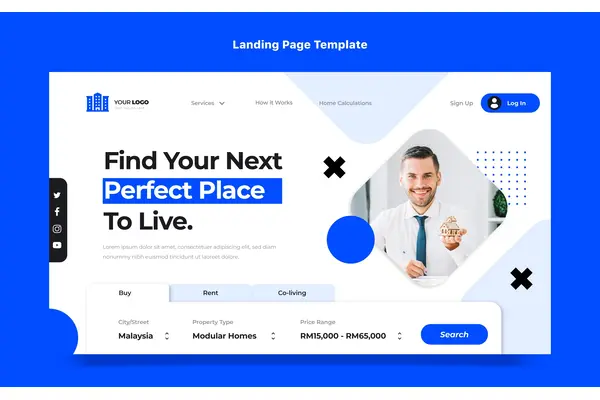
In a competitive digital landscape, realtors need eye-catching website designs that capture the attention of potential buyers and sellers alike. Your website is often the first impression clients have of your business, and a visually appealing design can make all the difference in converting leads into customers.
Whether you're a seasoned realtor looking to refresh your online presence or a new agent looking to make a splash, this guide will provide you with the tools and insights you need to create a website that not only attracts attention but also drives conversions.
With a deep understanding of the real estate industry and the latest web design trends, we'll show you how to optimize your site for search engines and deliver a seamless and memorable experience for your visitors. Get ready to take your real estate business to new heights with an eye-catching website design that leaves a lasting impression.
Creating an eye-catching website design involves a combination of aesthetics, functionality, and user experience. Here are the key elements to consider when designing your real estate website:
The choice of colors and typography can greatly impact the overall look and feel of your website. For real estate websites, it's important to choose colors that evoke trust, professionalism, and a sense of luxury. Here are some tips for selecting color schemes and typography:
Neutrals such as whites, grays, and beiges create a clean and sophisticated look. They also allow your property photos to take center stage without distractions.
Add a pop of color to highlight important elements such as call-to-action buttons or headlines. Choose colors that complement your brand identity and evoke the desired emotions.
Select fonts that are easy to read on both desktop and mobile devices. Sans-serif fonts are often preferred for their clean and modern look, while serif fonts can convey a more traditional and elegant feel.
With more people accessing websites on mobile devices, it's crucial to ensure your real estate website is responsive and mobile-friendly. Responsive design ensures that your website adapts to different screen sizes and provides a seamless user experience across devices. Here are some tips for mobile optimization:
Compress and resize images and videos to reduce load times and improve mobile performance. Use responsive design techniques to ensure media content adjusts to different screen sizes.
Simplify your website navigation for mobile users. Use dropdown menus or hamburger menus to save space and make it easier for visitors to find what they're looking for.
Consider how users will interact with your website using touch gestures. Ensure buttons and links are large enough to be easily tapped and spaced out to prevent accidental clicks.
An intuitive and user-friendly navigation system is essential for guiding visitors through your website and helping them find the information they need. Here are some tips for designing a user-friendly navigation and layout:
Limit the number of menu items to prevent overwhelming visitors. Use clear and concise labels that accurately describe the content they lead to.
Include a search bar on your website to allow users to quickly find specific properties or information. Make sure the search function is prominently displayed and easy to use.
Group related information together and use headings, subheadings, and bullet points to break up text and make it easier to scan. Use whitespace to create a clean and uncluttered layout.
As a realtor, showcasing your property listings effectively is crucial for attracting potential buyers. Here are some tips for presenting your listings in an eye-catching and informative way:
Invest in professional photography and videography to showcase your properties in the best light. Use high-resolution images and videos to capture the details and features of each property.
Write compelling and informative descriptions for each property. Highlight key features, amenities, and location details to help potential buyers visualize themselves living in the property.
Virtual tours provide an immersive experience for potential buyers and allow them to explore a property from the comfort of their own homes. Consider using 360-degree photos or virtual reality technology to create interactive virtual tours.
Testimonials and social proof are powerful tools for building trust and credibility on your real estate website. When potential buyers and sellers see positive reviews and feedback from satisfied clients, they are more likely to trust your services and choose you as their realtor. Here's how you can leverage testimonials and social proof:
Collect testimonials from satisfied clients and display them prominently on your website. Include their full name, photo (with their permission), and a brief statement about their experience working with you. Testimonials that highlight specific results or achievements are especially impactful.
If you have positive reviews on platforms like Google, Yelp, or Zillow, showcase them on your website. Include the review rating and a link to the original review. This will validate your reputation and expertise in the real estate industry.